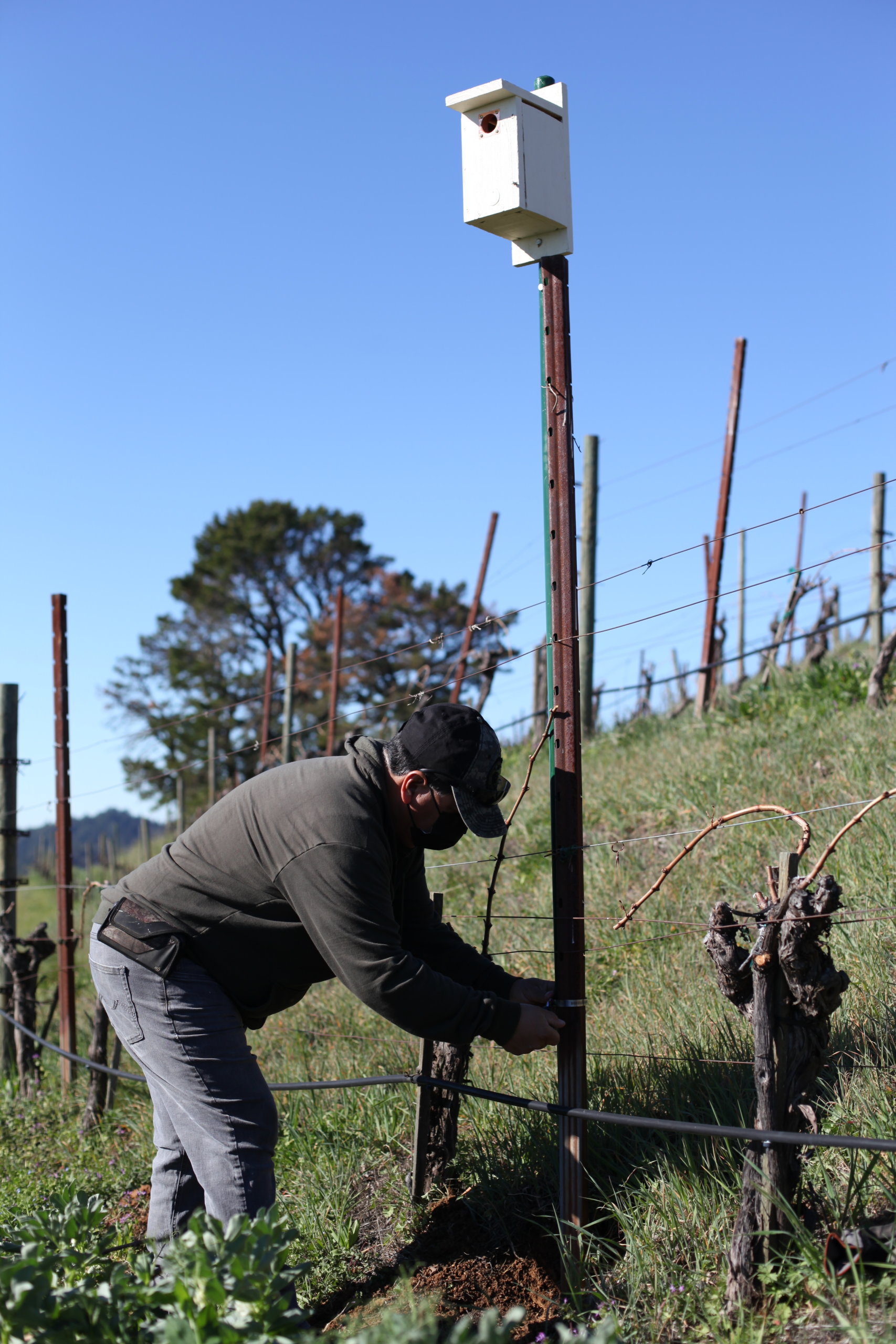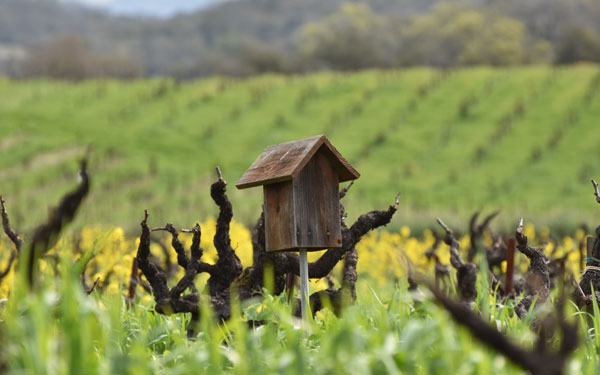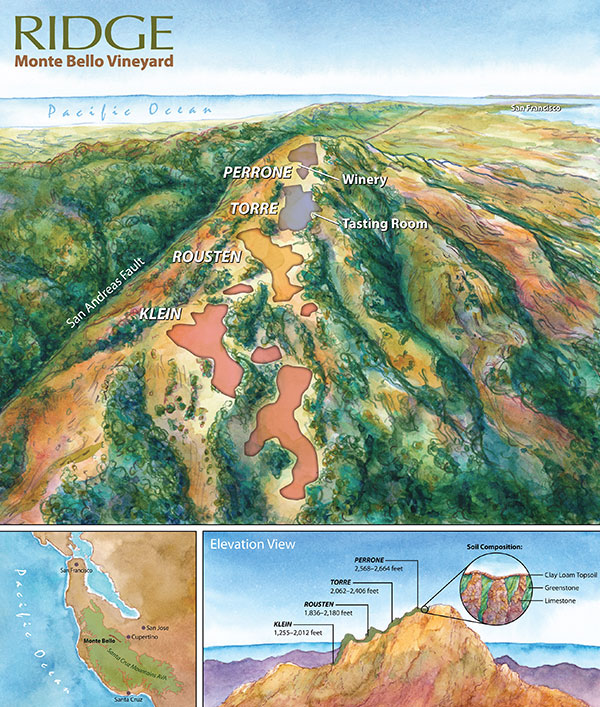Bird Nesting & Sustainability
Blog Post
One of the important ways that we increase biodiversity in our vineyards and naturally control predatory insects is to set up habitats for birds. Secondary nesting birds like the Western Bluebird can thrive in vineyard locations if provided with proper areas to nest.
Ridge Senior VP of Vineyard Operations, David Gates, speaks to our wildlife monitoring program here at Ridge: “Setting up Bluebird habitats is an excellent way to use the checks and balances involved with nature to our advantage in the vineyard. They consume nothing but insects – and a lot of them. They are smart birds, they like humans, and Monte Bello is the perfect location for them. With our partners and the California Bluebird Recovery Program, we can quantify our efforts to better improve our biodiversity.”
The Western Bluebird
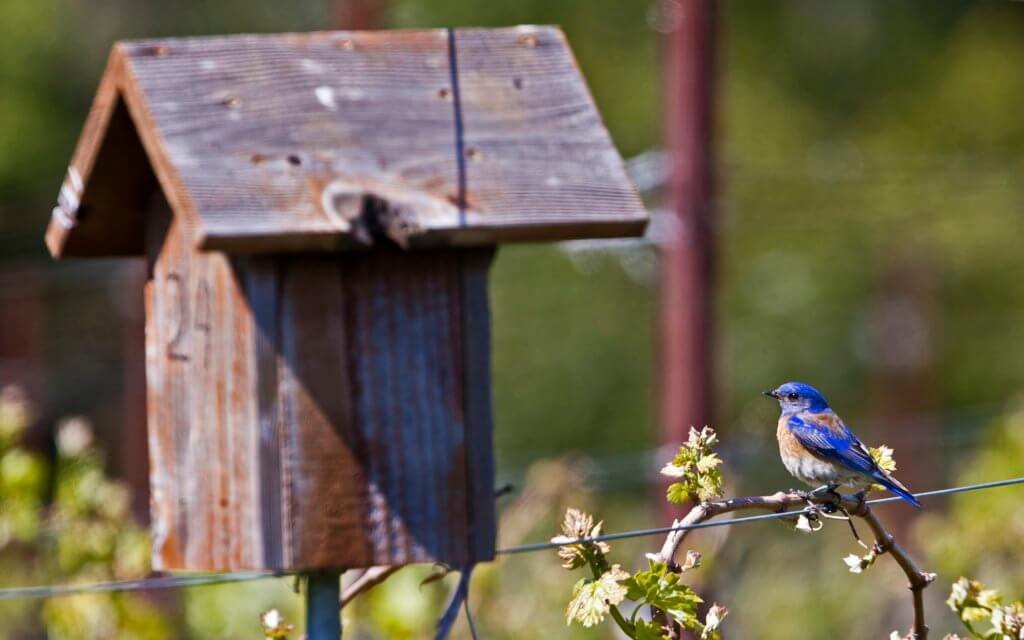
“Considered iconic as a symbol of happiness, included in folklore, art and music, Native Americans believed bluebirds embodied renewal and sunrise.”
What is a “Secondary Nesting Bird?”
“Bluebirds are classified as ‘secondary-cavity nesting birds’ because they do not possess the physical capabilities to make their own cavities. They, like other secondary-cavity nesters, nest in cavities caused by decay in dead or dying trees, cavities made by ‘primary-cavity nesting birds,’ or artificial cavities (nest boxes) constructed by humans.
“Due to loss of habitat due to agricultural and urban sprawl plus excessive use of pesticides, bluebird populations plummeted by the 1970’s. People often remove dead or dying trees, and this has contributed to the loss of natural cavities for cavity nesting birds. The introduction of competitive, invasive, and often vicious bird species such as House Sparrows and European Starlings has also impacted bluebirds. Nest box programs effectively support the conservation of bluebirds thus, increasing their survival and population growth.” -Patricia Jordan, California Bluebird Recovery Program
Building an Effective Habitat
The Bluebird’s habitat needs to have food, water, cover, and places to raise its young. Choose an area with open, grassy fields and native trees away from excessive human activity or construction. It’s also a good idea to place your nesting box where there are trees or shrubs close by so that fledglings have a nearby place to land on their first flight. Other important considerations are:
- Keep boxes raised at least five feet off the ground
- Add holes to the bottom of the nest box to ensure proper drainage of rain and encourage air circulation
- Forego adding a perch, as this encourages predators
- Place nest boxes in areas with ample shade and/or paint the exterior of the box a light, natural color to reduce the heat inside.
- Continue to monitor boxes and monitor boxes weekly. The high number of second broods is greatly enhanced by promptly removing unhatched eggs and dead nestlings so that ants and bird mites are not attracted to the nest box. These pests can overrun and kill remaining healthy nestlings. Also, weekly monitoring allows for the removal of completed or defunct nests from boxes so that boxes are quickly made available for new nesting attempts.
The 2021 Nesting Season
The Ridge nesting season covered four months from March 10 to July 10, 2021. Initial nesting activity was seen at Jimsomare (Klein), La Casita on March 10th. The season concluded with the last fledgling at Perrone on July 10th. Only four of the 46 boxes were unused during the season, an excellent occupancy rate of 91.3%.
The 2022 Nesting Season
The 2022 Ridge Vineyard Monte Bello Estate nesting season was not as successful as in 2021, primarily due to weather conditions. The nesting season covered five months from March 9 to July 26, 2022. Initial nesting activity by Western Bluebirds was seen at Rousten and concluded with two Ash-throated Flycatchers fledging at Perrone on 7/26/22.
58 of the 69 boxes were used during the season, an occupancy rate of 84.06% vs. the 2021 occupancy rate of 91.3%. This 6.7% decrease in occupancy rate is not a major concern since 23 new boxes were added this year, and other boxes were moved to new locations.
Ranch-Specific Data
Perrone:
2021: Perrone was the most successful nesting location on the estate. All four boxes at this location had successful fledglings and three of the boxes had two successful broods.
2022: With 6 boxes – 4 old and 2 new – Perrone was the least successful during the 2022 season. This Ranch was the most obviously impacted by the early warm, then cold and wet weather cycles.
Torre:
2021: Torre was the least successful nesting location during the 2021 season. All 13 boxes had at least one nesting attempt but very high temperatures over several consecutive days may explain the failure of one box to fledge mature nestlings. A second box failed, very likely due to House Wren predation. Four boxes had two nesting attempts, but only one was successful. Three other attempts failed for similar reasons.
2022: With 14 boxes – 1 new box and 13 old boxes – Torre was the only Ranch with a higher Nesting Success Rate than in 2021. However, the Fledglings per Box value is lower than the other three ranches because there was only one successful second nesting attempt. Only one box, #29, was unused. Two boxes failed; one due to cold, wet, and windy weather and the other, a new box, due to cracked eggs.
Rousten:
2021: Rousten was also very successful. Of eight total boxes, all eight had fledglings and two had second broods, although only one was successful. The failed second attempt with three unhatched eggs and two dead nestlings was very possibly due to the three days of extremely high temperatures that exceeded 100 degrees.
2022: Rousten was the most successful ranch this year, both by Fledglings per Box (4.43) and Nesting Success Rate (87.10%), only 2.9% less than 2021. Five of the new 15 boxes were unused (new boxes/new locations). 12 of the used 18 boxes had second broods and 8 of these boxes had two successful broods! The impact of the low occupancy rate was reduced by a high rate of successful second broods.
Jimsomare (Klein):
2021: Jimsomare was the third most successful nesting location. Among the 21 boxes, three boxes were never used – one at Lower Chardonnay and two at Middle Chardonnay. One box at Casa Grande had a nest but no eggs. The remaining 16 boxes had at least one successful nesting attempt. La Casita was very productive with two boxes that fledged 14 birds and one of these boxes a second brood.
2022: Jimsomare had the second highest Fledglings per Box (due to 12 second broods) but a lower Nesting Success Rate (due to a 33% Death Rate). Four boxes were not used. The remaining 19 boxes included 12 boxes with second broods, 4 of them where both attempts were successful. Jimsomare was the only Ranch with more fledglings per box compared to last year.
Open Space Preserve (OSP) – New!
2022: OSP, with 3 new boxes on a new ranch and with vines being planted during the nesting season, was surprisingly successful – 2 of the 3 boxes produced fledglings. One box was not used, one attempt failed, and the remaining attempts were successful with one box producing a second brood with 10 fledglings.
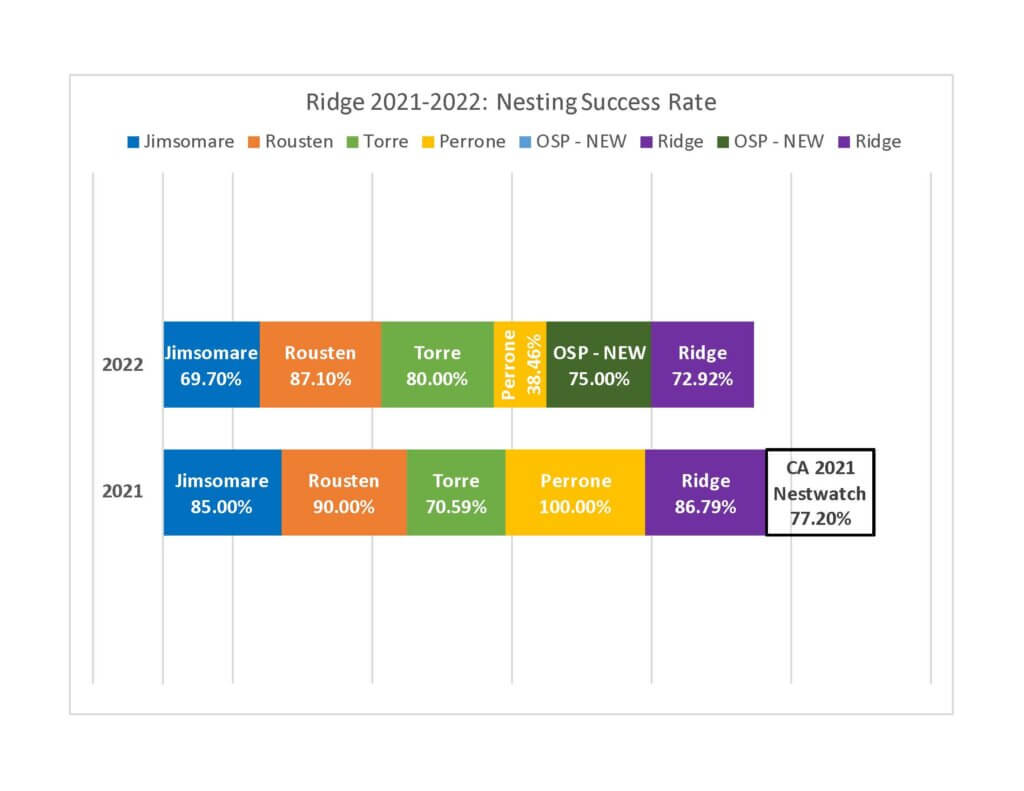
Summary
The 2021 nesting success rate of 86.79% exceeded California’s 2019 (last normal pre-pandemic year) overall data by 10.82%, as reported to Cornell’s NestWatch. This result is excellent and benefits both the Western Bluebird population as well as Ridge’s goal of using native species to eliminate pests from the vineyards.
The 2022 nesting success rate of 72.92% was 13.87% lower than Ridge’s 2021 nesting success rate, primarily due to weather conditions early in the season. However, Ridge’s nesting success rate was only 6.04% lower than CA Nestwatch 2021 nesting success rate of 78.96%.
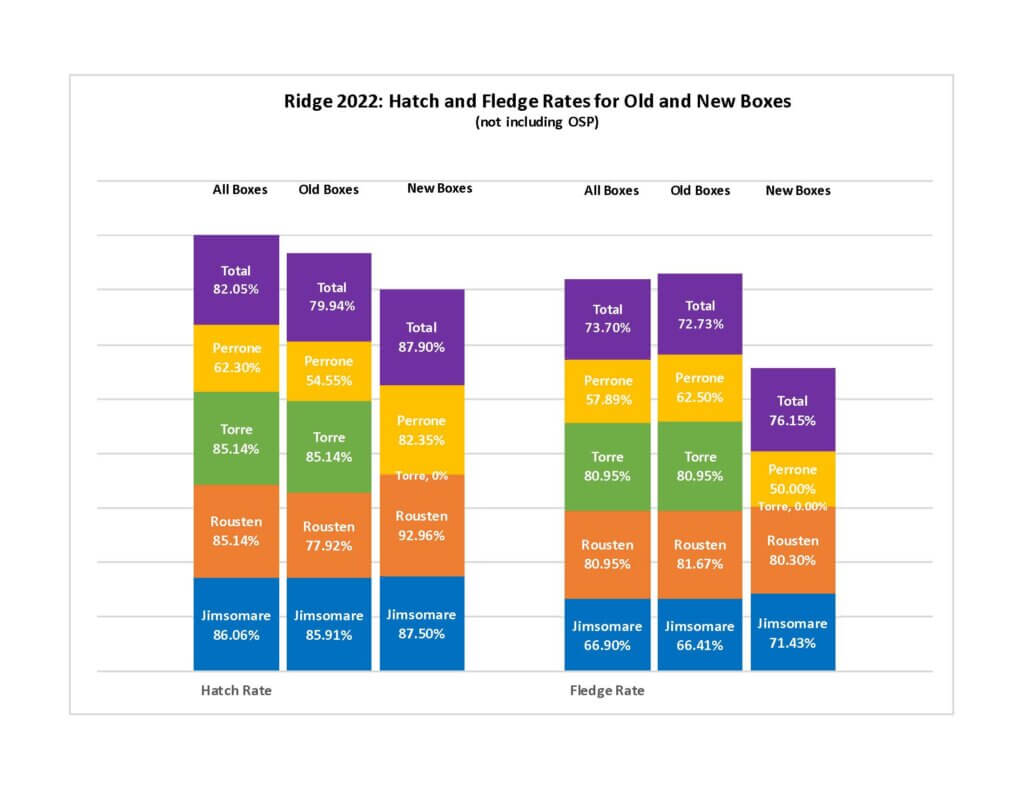
The Future of Bluebird Nesting in our Vineyards
We will continue to monitor each season’s nesting results at all four of the historic ranches on our Monte Bello Estate and provide updated reports yearly. We plan to use our findings to establish successful nesting trails at our other estate vineyards.
To learn more about Bluebird nesting and find thorough guidelines on how to build your own nest box, visit the California Bluebird Recovery Program website.
Nesting data provided by Patricia Jordan and Wild Farms Alliance.
Wait!
In order to qualify for user related discounts, you must log in before proceeding with checkout. Click the button below to log in and receive these benefits, or close the window to continue.
Log In